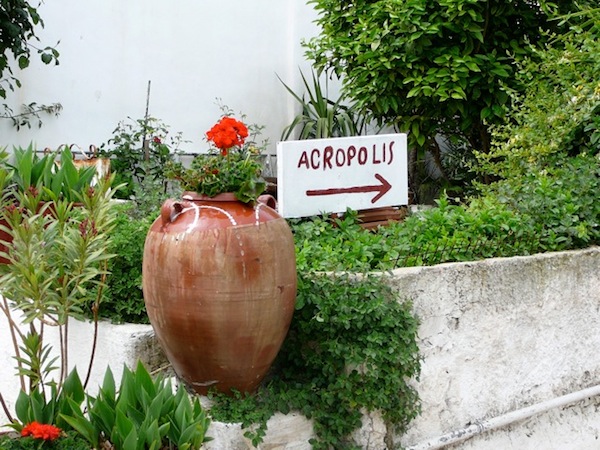Athens Through Other Eyes
Eating Well Is The Best Revenge
by Diana Farr Louis
ATHENS Greece—(Weekly Hubris)—5/23/2011—“We love your beautiful city.” The couple from Brisbane took me by surprise. It’s been so long since anyone has had something nice to say about The Big Olive, beleaguered as it is by strikes and demonstrations, its reputation clouded not by our famous nefos (cloud of smog) but by nefarious scandals.
“What exactly do you love about it?” I ask.
“Oh, the atmosphere. The people. They are the nicest in the world. Smiling, helpful, and always doing their best to understand us.”
I nod a bit cynically. Ted and Margaret’s Aussie accents might challenge even some more practiced English speakers. But from where we are sitting, you can’t fault the atmosphere.
At dusk, the terrace of the Athens Gate Hotel is a front row seat for the best show in town. On the Acropolis to the west the Parthenon shines with an ethereal light. Directly below us we have Hadrian’s Arch and the columns, tumbled like sliced bread, or upright, of Olympian Zeus. Beyond it, set like a gemstone on its low slope, glows the topaz oval of the Stadium, originally built by Hadrian’s pal, Herodes Atticus, and restored for both of our Olympic Games. To the north, even the ochre Parliament building looks deceptively harmonious. And from the highest point, Lycabettus Hill, the white church of St. George seems to cast a blessing on us all.
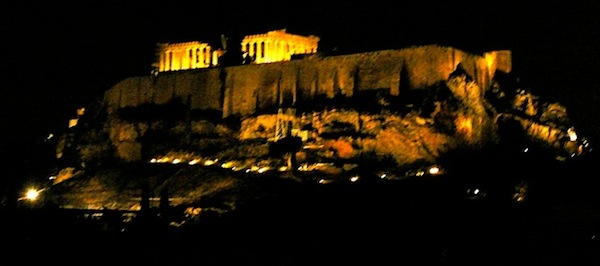
I realize to my astonishment that I have never, in all my decades here, seen Athens from quite this vantage point. And it is glorious.
I’d been wandering in these precincts for the previous two days with a high school classmate I hadn’t seen in more decades than either of us cares to reveal. The day before she arrived from San Francisco, Athens was in more turmoil than usual. A man had been knifed for the sake of a video camera hanging round his neck, while he went for his car at 5 a.m. to take his pregnant wife to the maternity clinic. Neofascists had erupted in a frenzy of migrant-bashing in retribution. A general strike paralyzed transport, banks, and all public services. Molotov cocktails landed at the feet of the riot police, and one responded by clubbing a fallen protester. A scene repeated ad nauseam on the evening news.
I did not mention a word of this to my old friend. There was too much to catch up on. But I didn’t want to scare her, either.
So we went about our sightseeing and I put on my tourist shoes. First stop, the new Acropolis Museum, which even if you object to the architecture contains spectacular works—most notably the Archaic sculptures. Still bearing traces of what must have been fairly gaudy paint, they radiate youth and innocence.
Masterpieces are no surprise, but the museum café proved far better than expected, contradicting the maxim that the more stunning the view/location, the more disreputable the food. We ate simply: an enormous, colorful salad of mixed lettuces dressed with oil and petimezi (grape must molasses) instead of vinegar, one of the best spinach/feta pies I have ever tasted (and that is saying something), a glass of wine, dark baguette slices and breadsticks, all for a more than reasonable 15 euros.
For dessert, we took a stroll through Plaka. Here the jumble of ancient, Roman, Byzantine, Ottoman, neoclassical, and kitsch never fails to amuse and intrigue me. Stylish graffiti cover some façades, aggressive scribbles mar others, while bits of antiquity show up in unlikely places. Sometimes, eerily, under plexiglas floors in boutiques.
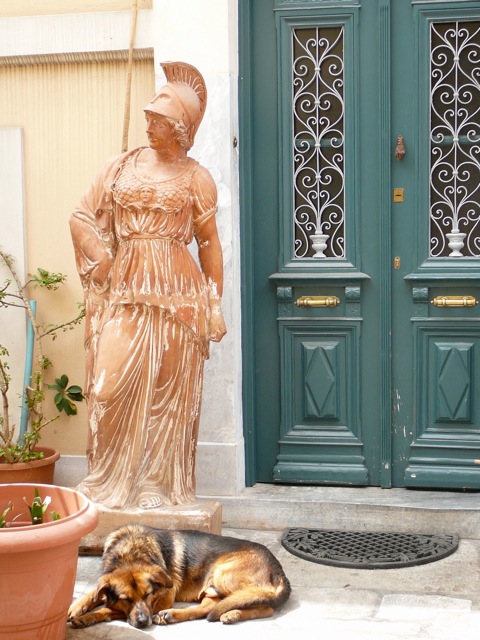
On Adrianou, the main shopping street, there is a modicum of hustling, but gently done with a smile. And here, too, the atmosphere is congenial. All the tourists, many of them Americans, wear big smiles and chatter loudly.
The next day, we meander through the middle Plaka over to bustling Ermou, named for Hermes, the god of Commerce. M is impressed by the elegant clothes and ubiquitous shoe stores, and looks longingly at the vendor surrounded by sesame rings. We give a tiny offering to the hurdy-gurdy player, who croaks a feeble tune while he cranks out a couple of tinny notes.
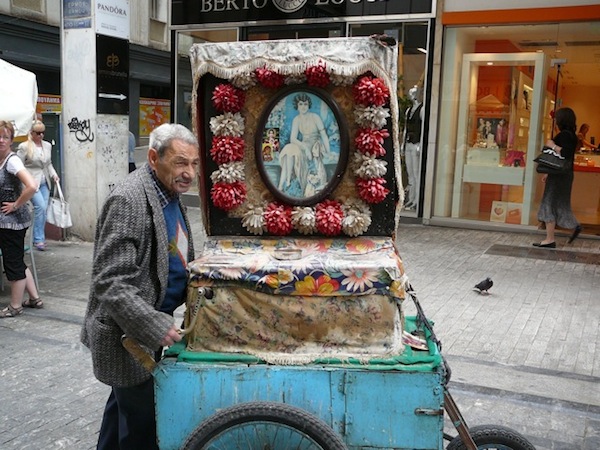
The emptyish back streets towards the Central Market tell a different story. Some are empty, plastered with “for rent” signs; others still promise treasures among their enormous caches of buttons, ribbons, beads, art supplies . . . .
Nothing about the Market area shows a hint of crisis or unrest. It’s business as usual—shouts, banter, “Where are you from, Ladies?”—as we file past the gory spectacle of dangling lamb carcasses, chickens, pigs’ trotters, and beef heads, before trying to avoid the puddles in the fish section. Everything looks temptingly fresh with the possible exception of the ginormous crabs flown in from Alaska.
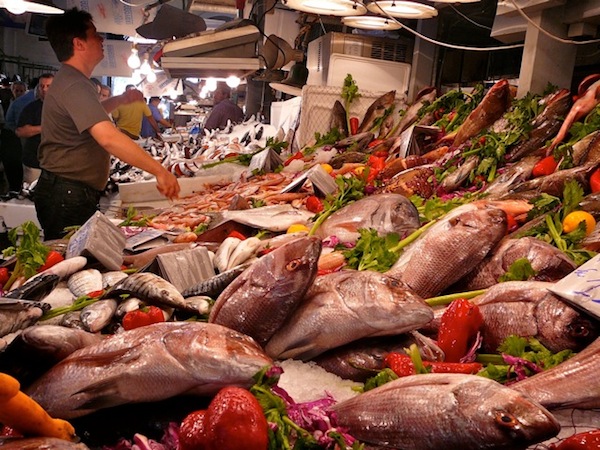
Outside again, M spends minutes ogling the dried fruit and nut stalls, the buckets of snails, the veg stalls with unfamiliar greens, lethal looking artichokes, and carefully stacked vine leaves. And then, on the spice street, finds her heart’s desire: tiny bars of olive oil soap for guests. I’m happy here, too, reminded that I don’t have to go to Turkey to satisfy my urge for stringed curtains of chili peppers or bags of exotic seasonings.
For lunch, we go to an institution, Doris (at 30 Praxitelous Street, 210 3232671). Our illustrious WH editor introduced me a few years ago; M has read about it in the NY Times. It’s unpretentious and excellent, classic Greek home cooking, with a huge bonus for dessert—loukoumades (doughnut holes) with honey and cinnamon, served on the house.
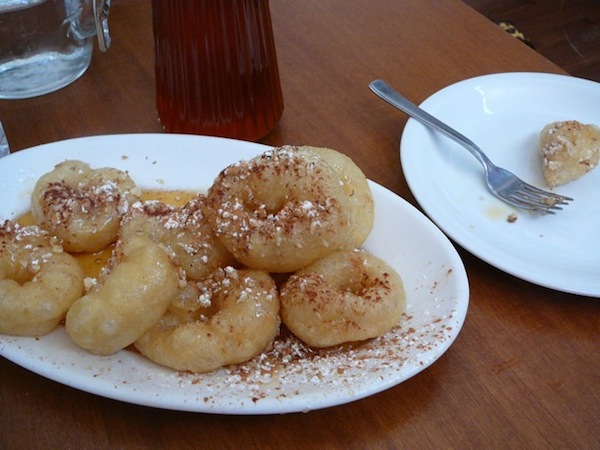
Good though our “little shoes” (papoutsakia/meat-stuffed eggplant) and meatless moussaka are, we cannot finish them. This provokes a lecture from our waitress, about the starving poor and her parents who lived through the Occupation. I accept the reprimand, which takes us back to our post-War childhood, but suggest that perhaps the Bavarian/Texas-size portions may play a role. “There’s that, too,” she concedes.
We walk back slowly to M’s hotel. The weather is perfect. Here and there, newly planted geraniums and marigolds brighten small parks. I still spy no hint of recent violence. Until a mound of faded bouquets wrenches my heart. They’re stacked in front of the blackened Marfin Bank, where three young employees were burned to death during a general strike last May by “anarchists” throwing Molotov cocktails. They murdered their compatriots, calling them “scabs,” and have never been caught.
I describe the tragedy quickly, not wanting to spoil M’s enjoyment, her obvious pleasure at peaking into off-beat nooks and crannies while avoiding the plastic Parthenon and T-shirt emporia. We’ve walked so far that her bad hip is complaining and, as we’re trying to recall the last time we heard a wolf whistle, a peddler appears out of nowhere to offer us a fancy cane. Sending us into hoots of laughter, while three laborers, sitting on a curb, join in the fun.
That night, coming out of a theater near Hadrian’s Arch, we’re stopped in our tracks for countless minutes. It’s impossible to cross as thousands of cyclists burst out of the broad pedestrian street below the Acropolis onto the main thoroughfare of Amalias. They bring a surge of excitement, energy, youth, and optimism.
All along our route for the two days I showed my friend around Athens, we kept looking up at the Parthenon. Though damaged by time, plunder, war and pollution, it still symbolizes the best that we humans can aspire to and, sometimes, briefly, attain.
I’ll try to go downtown more often, for a dose of eternal Parthenon and of the cheer Athenians wear for visitors—to counteract the negativity that assails us natives daily.
The Greeks have a saying: “I Ellada pote den pethainei.” Greece will never die. But we do need to decide which Greece we want to survive.
